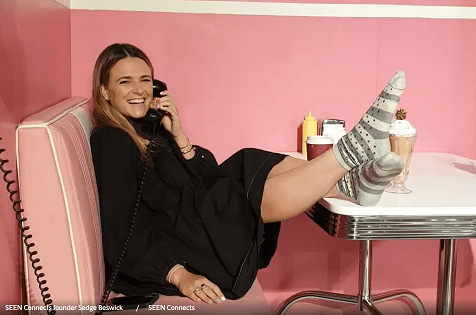By Lucy Tobin
When Sedge Beswick started at ASOS in 2012, the social team consisted of one person — her. By the time she left four years later, she headed up a team of 32, having launched ASOS’s first influencer programme.
That launched the careers of influencers including Freddie Harrel and Leonie Hanne – but Beswick then left to start her own influencer marketing agency, SEEN Connects, which has now grown to a £20 million-a-year turnover business working with thousands of influencers and celebrities including Lewis Capaldi, Tom Daley, Roberto Carlos, Myleene Klass, Jack Whitehall and Kurupt FM. Here, she reveals that working in the ‘new’ tech industries can still involve battling age-old discrimination.
“I founded SEEN Connects thanks to an 18-minute meeting with an investor over a coffee. I am an enthusiastic person – all jazz hands and fast-talking – and in those pivotal minutes, I’d made the case for an influencer marketing agency that focused on creativity and ROI [return on investment].
“At the time, I wasn’t even sure if I would stay on after setting up the business. I felt like defining the business’s USP would be my sweet spot. But then we signed Nike and Instagram in our first week, followed quickly by Very.co.uk. I was immediately hooked and realised I was right, there was a gap in the market for SEEN Connects and my vision of influencer marketing.
“We work with big brands to come up with creative ideas, recommend influencers and celebrities and then use our data team to work on the client’s ideal ROI – it could be a huge bank of content for their internal streams, it could be increasing the average basket value, or conversion to sales on a website, or app downloads. The business took off fast, but it wasn’t all smooth-running. Fairly early on, I flew out to Bangkok to meet a travel client, the Thai base of an entertainment travel company.
“The client and I had been emailing back and forth for a while and though I thought the messages were quite lad-y, but I wasn’t fazed, I’m happy with not being ‘corporate’ too. But when I arrived in Bangkok for the job – along with three influencers who had two million followers between them – it became clear the client hadn’t clocked that ‘Sedge’ was a female name. Let’s just say we didn’t receive a warm welcome.
“I got to reception, was greeted by the business owner, who just said, ‘Where is Sedge? I said, ‘I AM Sedge.’ And he just responded, ‘What? I don’t do business with women. I need to speak to a man.’ I was so taken aback I didn’t even know what to say.
“The influencers were more outraged than me and were desperate to talk about it on their socials. But I didn’t want them expressing their negativity with the brand before we’d even started – I had to say it was ‘just cultural differences, please don’t tweet!’
“But I wasn’t sure what to do with this client, as I didn’t have any men with me on the trip. In the end, I said my CFO is a man, he’s based in London. So this client would phone London to speak to the CFO, who would call me, and tell me what we had to get done. It was bonkers – and the client wouldn’t speak to me directly for the entire trip. His reaction was extreme and offensive.
“We managed to complete the project, and once we got home, he said he wouldn’t pay for the work either. The whole cursed trip to Thailand was the worst moment in my career.
“It did, though, teach me a lesson on due diligence that’s helped ensure my team has never been put in a vulnerable position like this. As an employer, it’s something I’d never want to put my team through. I now make sure we do video calls rather than purely emails before working with and meeting a client, I make sure our legals are in check, and for smaller, more emerging businesses, ask for upfront payment.
“I’ve been comparatively lucky that I’ve only experienced the bluntest edge of sexism once. When we launched SEEN Connects in the US, I found no discrimination but plenty of cultural differences: in New York I have to do far more lunches and dinners, brands demand more TLC from agencies, whereas in the UK people just want things done quickly.
“A lot of people in [the Bangkok] situation would have been shocked to their core – but my nature is to be pretty pragmatic. I just think – it’s happened, move on, don’t put yourself in that situation again. Being bold is paying off – by the end of 2022, and at the pace we are growing, we should be close to 100 people at SEEN Connects. You can’t succeed in business if you’re always anticipating the worst-case scenario. I haven’t been back to Bangkok – but I blame that on the pandemic, not on my last Thai experience.”


